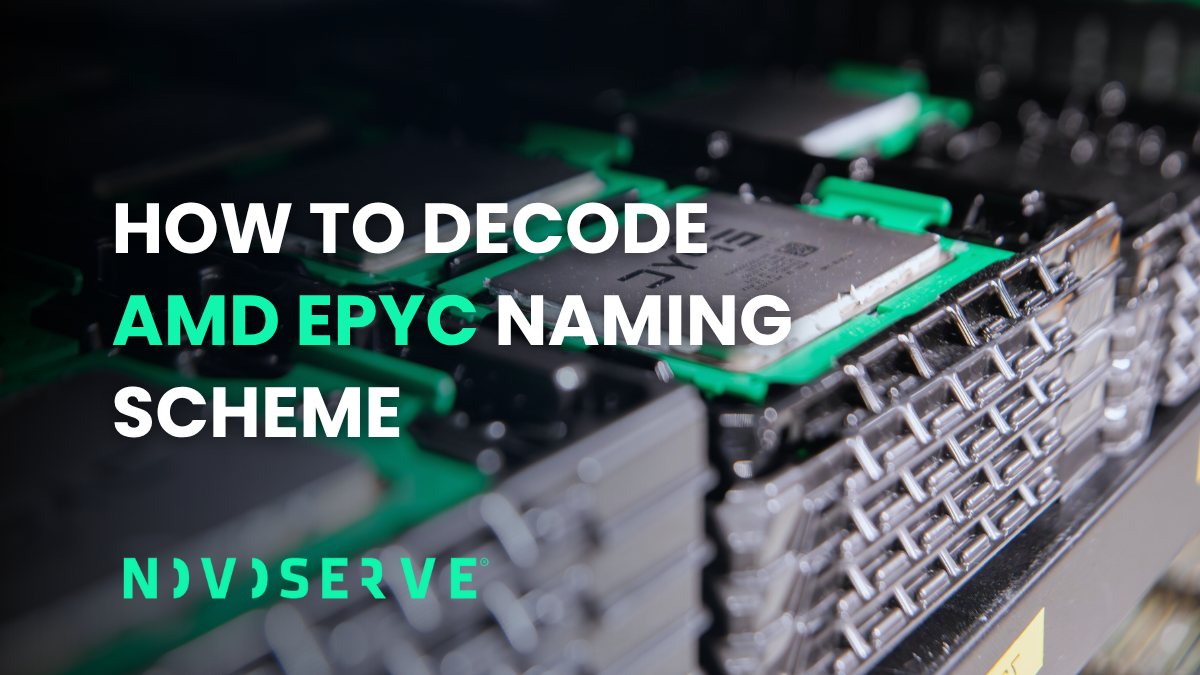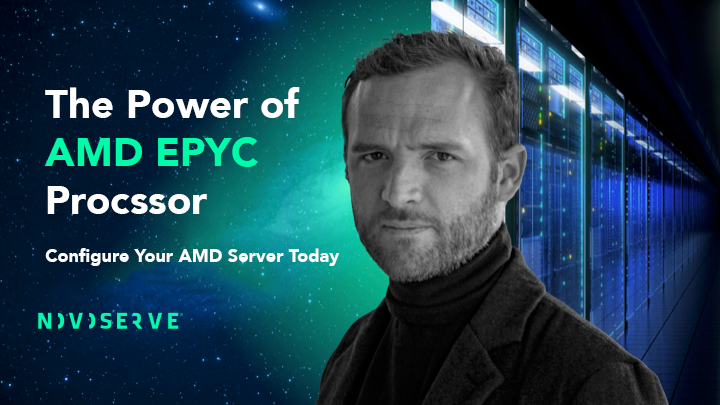For tech professionals, understanding this AMD EPYC helps you to choose the right AMD server—one that is perfectly matched to your workload, budget, and performance goals.
Let’s break down the AMD EPYC naming scheme, and then walk you through how we pair these powerful processors with our latest chassis from HPE and Supermicro to build the ultimate AMD EPYC server for your tech business.
The AMD EPYC naming scheme
The first step in choosing the right CPU is learning the language. The AMD EPYC model number is a logical code that reveals the processor's core count, generation, performance tier, and special features. Our diagram below provides a quick visual reference.

Let's break down each component:
- First Digit: The Product Series This number indicates the processor family and its corresponding socket. It's the first indicator of the platform's generation.
- 9xxx: Signifies the latest EPYC 9000 Series (Genoa, Bergamo, Turin), which uses the advanced SP5 socket and supports next-gen tech like DDR5 and PCIe 5.0.
- 7xxx: Signifies the powerful and widely adopted EPYC 7003 Series (Milan), which uses the SP3 socket.
- Second Digit: The Core Count This is your at-a-glance guide to the CPU's parallel processing capability. A higher number means more cores. For example:
- 7: 112-128 Cores
- 5: 64-72 Cores
- 3: 32-36 Cores
- Third Digit: Relative Performance This digit (from 1-9) gives an indication of the CPU's performance characteristics within its family, often related to clock speed and cache size. A higher number generally means better overall performance.
- Fourth Digit: The Generation This number confirms the CPU's underlying "Zen" architecture generation, which is a key indicator of its efficiency and instructions-per-clock (IPC) performance.
- 4: 4th Gen (Zen 4)
- 3: 3rd Gen (Zen 3)
- 2: 2nd Gen (Zen 2)
- The Suffix Letter: The Specialization The final letter is crucial, as it tells you the processor's intended use case.
- P: Optimized for 1P (single-processor) servers.
- F: A High Frequency model, perfect for workloads that depend on raw single-thread speed.
- X: Features AMD's massive 3D V-Cache™, ideal for technical computing and specific database workloads.
- S: A special designation for high-density, cloud-native workloads, often featuring the highest core counts.
Our popular AMD EPYC servers
Now that you can decode the names, let's see how these processors fit into our enterprise-grade hardware solutions.
The Battle-tested workhorses: AMD EPYC 7000 series
These processors are our most popular and best-selling for a reason: they offer an incredible balance of performance, core count, and value. They are the reliable foundation for countless businesses. Our most popular models are the 64-core powerhouses: the EPYC 7702, 7713, and 7742.
We build these CPUs into the industry-standard HPE ProLiant DL325 Gen10 (for single-socket) and HPE ProLiant DL385 Gen10 (for dual-socket) servers. They are best for high-density virtualization, large-scale SaaS platforms, and any workload that needs massive multi-threaded performance without the price tag of the latest generation.
The next-generation powerhouses: AMD EPYC 9000 series
When your project demands the absolute pinnacle of performance, the AMD EPYC 9000 series is your choice.
The hyperscale king: AMD EPYC 9754 With an incredible 128 cores and 256 threads, this CPU is a monster of parallel processing, purpose-built for hyperscale cloud environments and massive data analytics.
The high-frequency specialist: AMD EPYC 9374F This processor is the perfect example of specialization. With 32 cores running at extremely high clock speeds, it's the ideal choice for workloads where single-threaded performance is critical, such as certain databases or financial modeling applications.
We offer these next-generation processors in our cutting-edge HPE ProLiant DL385 Gen11 servers, which leverage the SP5 socket to support DDR5 memory and PCIe 5.0.
Specialized workloads: AI, GPU, and storage
For projects that require maximum density of GPUs or storage drives, customization is key. This is where our Supermicro H11 and H12 chassis shine. These flexible platforms allow us to build a highly tailored AMD EPYC server packed with multiple GPUs for AI training or dozens of drives for a high-capacity storage solution.
The power is in having the right AMD CPU
Choosing the right AMD server is about more than just picking the newest model. It's about understanding the specific architecture of the CPU and matching it to your workload. It’s about knowing whether you need the incredible value of a 64-core EPYC 7742 or the groundbreaking hyperscale power of a 128-core AMD EPYC 9754.
At NovoServe, we combine the full spectrum of AMD EPYC processors with enterprise-grade chassis from HPE and Supermicro, all backed by our premium global network and dedicated server technical support.
Ready to build your perfect AMD EPYC server? Explore our webshop or contact our team and find the right AMD EPYC CPU that matches your workloads.




